On the evening of January 26, 1983, as a technology-smitten Boston University freshman, I attended the monthly meeting of the Boston Computer Society, which included a demo of Apple’s brand-new Lisa system. Though I know that I came away enormously impressed, I don’t exactly recall the event like it was yesterday. Actually, just one element was permanently etched onto my brain cells: the moment when the Lisa’s bitmapped, proportional, user-selectable typefaces flashed on screen. It was a mind-bender given that other PCs–like my beloved Atari 400–were capable only of displaying a single fixed-width font of no elegance whatsoever.
In the subsequent three and a half decades, I either forgot about or misremembered every other aspect of the night. For instance, I didn’t realize that the same evening included a demo of the Apple IIe. (I recalled attending that, but not that it was paired with the Lisa one.) I thought that the meeting was held at Boston University’s Morse Auditorium. (Nope: New England Life Hall.) I wasn’t even sure if Steve Jobs had presided over the affair. (He didn’t, but was there a year later to show off the original Mac at a BCS meeting.)
Now, thanks to the miracle of the internet, I can relive every minute of that 1983 meeting. It was videotaped at the time by BCS member Glenn Koenig, who–with the help of the Computer History Museum–has digitized his work and made it available, along with other vintage BCS meetings, on YouTube. And here it is, beginning with BCS president/impresario Jonathan Rotenberg promising us “two major new computers, one of which I think you will agree is truly revolutionary.” That would be the Lisa, whose graphical environment was heady stuff indeed in the era of purely text-based interfaces.
As you might understand, I got a Proustian rush from revisiting the Lisa and Apple IIe demos I witnessed in person when I was 18, as one of 1,500-plus attendees who filled the hall and overflow space to capacity. We were the first members of the general public to see the machines, one week after Apple formally announced them at its annual meeting in Cupertino at De Anza College’s Flint Center. And in retrospect, we were unimaginably fortunate. After all, lots of Apple aficionados would kill to get into the one of the company’s current product launches, but only members of the press, VIPs, and various other invited guests need apply.
What I didn’t realize until I watched the video is that seeing the meeting all over again wasn’t just an act of personal nostalgia. Between them, the IIe and Lisa, and the way Apple explained them to us BCS members, are full of lessons that remain resonant in the era of the iPhone.
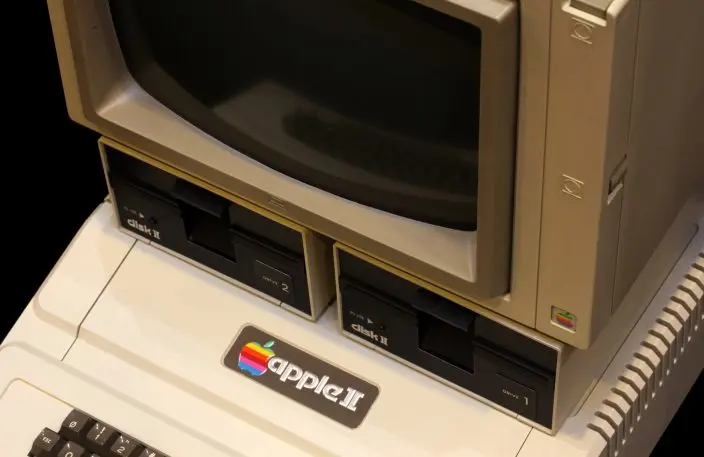
Setting The Stage
The fact that Apple chose to introduce two new computers to the public at a Boston Computer Society meeting was no shocker–actually, it would have been more surprising if it had done so anywhere else. Rotenberg had cofounded the organization at the age of 13 in 1977, the same year that the Apple II and its archrivals, Radio Shack’s TRS-80 and Commodore’s PET 2001, hit the market. At first, its membership could squeeze into his high school’s library. But as interest in personal computers exploded, so did the BCS. The group had 3,000 members by the end of 1981 and 7,000 in early 1983, and its influence spread far beyond the Boston area.
BCS meetings became a key communications vehicle for the entire PC industry. At one of the first ones I attended, in 1979–when the proceedings had migrated from Rotenberg’s school’s library to its more spacious cafeteria–Dan Bricklin and Bob Frankston showed VisiCalc, the first spreadsheet. Available only for the Apple II at first, the software helped sell that machine to business users, thereby becoming the killer app that defined the concept of killer apps. (Later on, Bricklin and Frankston’s company, Software Arts, subsidized Koenig’s videotaping of BCS meetings such as the Apple IIe/Lisa one.)
“By 1983, most companies felt that it was almost part of the product rollout process to present it to the largest user organization, to get the feedback and reaction,” Rotenberg recalls. “It was really where the rubber hit the road in terms of the vendors having to face consumers,” adds David Needle, who attended BCS meetings, including the Apple IIe/Lisa one, both as a member and as a reporter for InfoWorld.
Apple was particularly invested in the opportunity to show BCS members its new products. “The idea that demonstration was an essential part of the education of the consumer started with the Apple II,” says Regis McKenna, the legendary marketing guru responsible for introducing the Apple IIe and Lisa, among countless other products from Apple and others, to the world. “Primarily because there was no prior product in the home or general use that was anything like a computer.”
“I remember the enthusiasm and the intelligence of the crowd,” says David Larson, who presided over the Apple IIe section of the January 1983 meeting as director of marketing for the Apple II line, a job he held until 1985. “It was a joy to be able to tell the world what we were doing. And to do it to a crowd like that who cared, and knew what we were talking about, was really cool.”
The Lisa portion of the meeting, meanwhile, was presented by John Couch, who joined Apple in 1978 and was in charge of the machine as the company’s VP of personal office systems. Couch left the company in 1984–and then returned in 2002 as VP of education, a position he retains to this day.
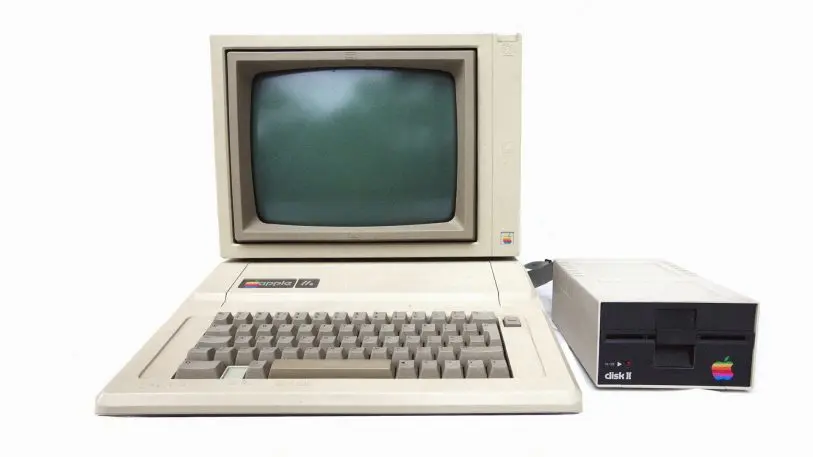
First, The Apple IIe
In a way that feels like a prototype of Steve Jobs’s later habit of saving “one more thing” for the end of a keynote, the BCS meeting began with the Apple IIe before getting to the far more groundbreaking Lisa. “The Apple IIe really came as a bonus,” Rotenberg says. “The meeting was originally just going to be the Lisa.”
As an update to 1979’s Apple II Plus–which was itself an improved version of 1977’s groundbreaking Apple II–the IIe was what its name suggested: a refinement of a refinement. The classic beige Apple II industrial design remained intact, tweaked only by shoving the Apple logo over to the left. The fact that it remained compatible with a gigantic existing base of Apple II software and add-ons was a major selling point.

Today, Larson describes the Apple IIe as “just a better version of the old thing that costs about the same money.” As its marketing honcho, he had to convince prospective buyers that the device was a signficant upgrade despite its familiar looks—much as the company must do to this day when people grumble that new iPhones look much like last year’s iPhones. One of Apple’s ads confronted this challenge directly, declaring that the IIe was “the same old Apple II. Except for the front, back, and inside.”
Much of what was new about the Apple IIe involved solving nagging problems and giving people more stuff as standard equipment. Both the Apple II and II Plus provided only upper-case characters unless you installed a third-party modification, which was anachronistic even in 1983; the IIe finally added lower-case ones. It also came with 64KB of RAM, which, though only .000008 the capacity of today’s most basic MacBook, was generous for an 8-bit microcomputer.
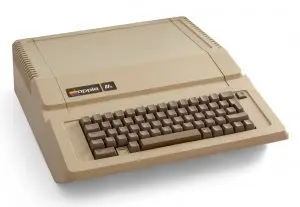
Another prime design goal of the IIe was invisible to the consumer: It was made to be easy to manufacture. Larson told the BCS members that when Steve Jobs and Steve Wozniak launched the Apple II, they’d devised a computer that they could hand-assemble in a garage rather than one that could be mass-produced by the tens of thousands. Consequently, the company reengineered the IIe from the ground up, reducing the number of integrated circuits from the II Plus’s 110 to just 31.
Apple said that downsizing the chip count improved reliability, which it did. But the biggest benefit was that it made the IIe less expensive to manufacture, and therefore more profitable. “The standard cost of that box dropped 60 or 70 percent,” Larson recalls. “They were radically cheaper. And we were selling the hell out of them. The margin was just extraordinary.”
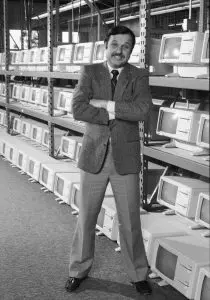
In April 1984, Apple announced the Apple IIc. (It was also featured at a BCS meeting which I have murky memories of attending.) Though its guts were similar to those of the IIe, the compact, snow-white case–crafted by Frogdesign’s Hartmut Esslinger—was radically different and sleeker. The IIc ditched expansion capabilities in favor of striving for appliance-like simplicity; offered LCD and battery options that turned it into a pseudo-portable computer; and generally catered to computing newbies rather than the enthusiasts and business users who made the IIe one of the industry’s mainstays.
Just as today’s Apple simultaneously offers both the familiar iPhone 8 and forward-looking iPhone X, it sold the Apple IIe and IIc and let customers decide which one spoke to them. The two models coexisted for four years–with the more expandable IIe outselling the sealed-up IIc–whereupon the IIc was discontinued. The IIe then outlived another major Apple II rethink, the vaguely Mac-like Apple IIgs.
Even in 1991, eight years after the Apple IIe’s release, the aging machine was such a standard in schools that Apple released an add-in card to allow Macs to run Apple IIe programs. Only in 1993 did the company finally discontinue the IIe, bringing the 16-year Apple II era to an end.
The Apple IIe’s decade-plus of existence makes it the longest-running Apple product of all time; it’s a little as if 2008’s iPhone 3G was still on sale today. Moreover, it may be the company’s most underappreciated computer, an enduring cash cow whose profits helped ensure that the failure of the Lisa–and disappointing sales for the Mac in its early days–weren’t existential crises for Apple.
With its emphasis on refinement over revolution–to excellent effect–what the IIe reminds me of most of all are the “s” model iPhones such as the 5s and 6s. They too lack novelty and therefore don’t get enough credit from tech pundits. (The Register’s Andrew Orlowski on the iPhone 5s: “Apple, you’re BORING us to DEATH.”) In 2017 as in 1983, consumers seem to understand the value of such products even if the technorati do not. I suspect that will continue to be the case when the company gets into future product categories that aren’t yet even a twinkle in its eye.
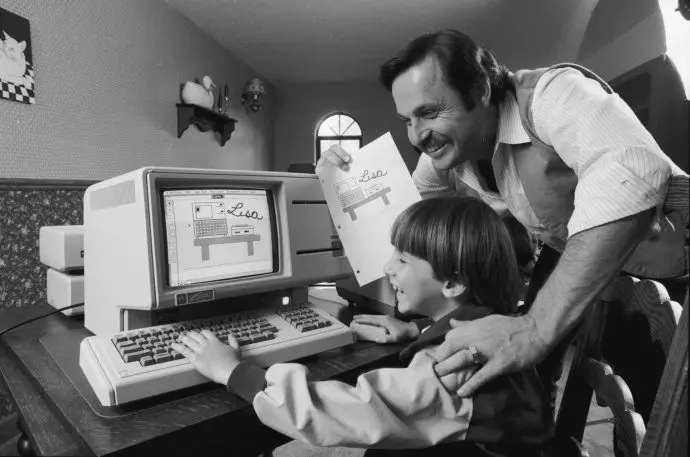
Lisa Revealed
After Larson wrapped up his half-hour Apple IIe demo, the BCS meeting segued directly into the Lisa demo by Couch and a colleague, which lasted more than twice as long. Though the news was big, the affair lacked the glitz of later Apple events such as Jobs’ Mac demo at BCS just a year later, which introduced the new computer to the strains of the Chariots of Fire theme. Couch began by quoting lofty praise for Lisa from publications such as Time (“It may change forever the way people communicate with machines”) but then informed the audience that he was going to spend more time showing than telling.
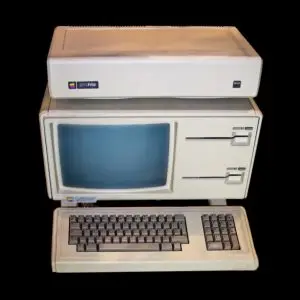
The features that Couch and his colleague show off couldn’t be more mundane by today’s standards. They include pointing and clicking with the mouse (“an ingenious cursor-positioning device”); dragging and dropping; multiple fonts at user-selectable sizes; a user interface that was consistent across the spreadsheet, word processor, and other apps; and a “wastebasket” which let you retrieve files after you’d deleted them. Virtually every one is still on use on every modern PC, but they were a revelation in 1983–especially if you hadn’t paid close attention to the work being done at Xerox’s PARC lab that so profoundly influenced the Lisa and every other computer with a graphical interface to come.
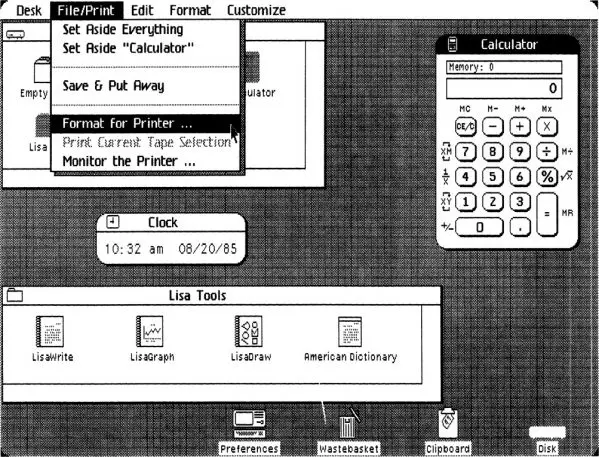
You can tell from Koenig’s video of the BCS meeting that the folks in the audience were amazed, even though you don’t get to see them until Couch fields some questions after the demo. Throughout, as they see elements for the first time, they applaud; they laugh; there’s even a gasp or two. Unlike many a modern tech launch event, the BCS crowd wasn’t filled with plants who’d been instructed to whoop it up. The reaction is heartfelt and spontaneous, and it’s coming from discerning computer users, not pushovers. (A year later, when Apple showed the Mac at a BCS meeting–presumably to many of the same people who’d been at the Lisa event–the still-novel cut and paste feature got applause all over again.)
One thing that doesn’t come up during the demo is the Lisa’s starting price: a daunting $10,000, or about $25,000 in current dollars. “A couple of thousand dollars, that was pretty typical,” says Needle. “But the Lisa really set a high-water mark, unless you were used to buying minicomputers. $10,000 for a personal computer, that just seemed crazy.”
As Needle’s InfoWorld report on the BCS event mentions, a BCS member buttonholed an Apple representative to ask whether it was true that an unannounced machine that the magazine spelled “MacIntosh” would cost only $2,000. The rep sidestepped the question, but the fact it got asked is evidence that even as it was being introduced to the world, Lisa faced competition from the Mac, which incorporated many of its features into a smaller, cuter computer with an innovative 3.5″ floppy drive.
When the Macintosh did show up a year after the Lisa, it cost $2,500–a price that was much higher than initially planned, but low enough to make the computer accessible to many individuals and businesses who’d never have bought a Lisa. It also had Steve Jobs, who had taken up the project after being ousted from the Lisa effort. Third-party software developers such as Microsoft embraced it. And it was boosted by a marketing campaign that was almost as iconic as the computer itself. Though the Mac got off to a slow start, it gained traction in a way that the Lisa never did.
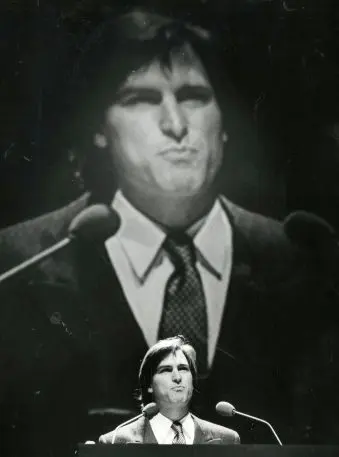
More than three decades after its demise, the Lisa isn’t exactly forgotten, but it’s most famous for being unsuccessful and short-lived. That strikes me as being terribly unfair, especially after watching the BCS video. Though it was a commercial failure, it bulged with ideas that went on to transform personal computing and that remain as relevant as ever. Any of us who attended that 1983 meeting would have instantly recognized this century’s Macs–and, for that matter, its Windows PCs–as being, essentially, souped-up Lisas.
For years, I’ve beaten myself up for not making time to attend the January 1984 BCS meeting at which Steve Jobs demoed the Macintosh, in an expanded version of the presentation he gave at Apple’s annual meeting in Cupertino a few days earlier. I don’t recall what kept me from going, but it’s possible that I expected not to be dazzled by the Mac, given that so many of its features were holdovers from the Lisa that had impressed me so much a year earlier.
I’m still sorry I wasn’t in the audience for Jobs’s Mac show. But I’m more grateful than ever that I was there for the Lisa. It really did blow our minds. And thanks to Koenig’s video, that meaningful moment in tech history is preserved forever.
Recognize your brand’s excellence by applying to this year’s Brands That Matter Awards before the early-rate deadline, May 3.
